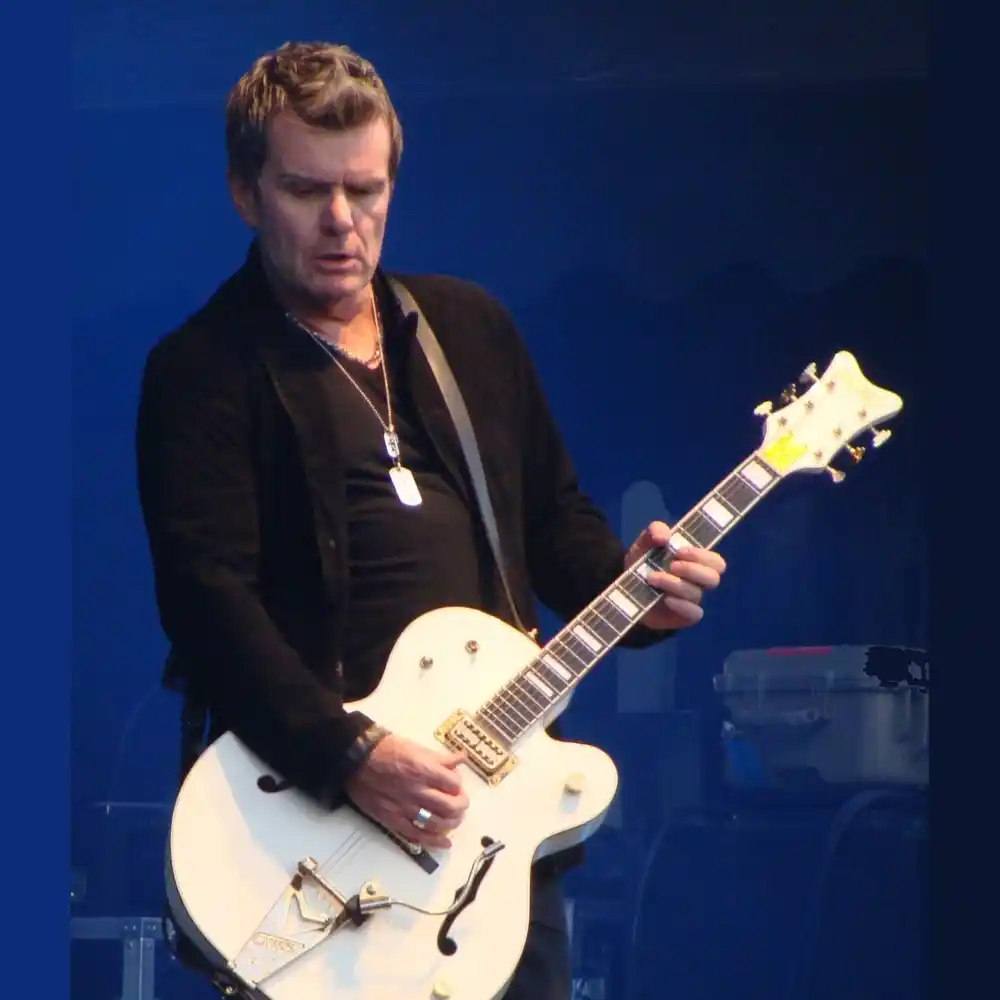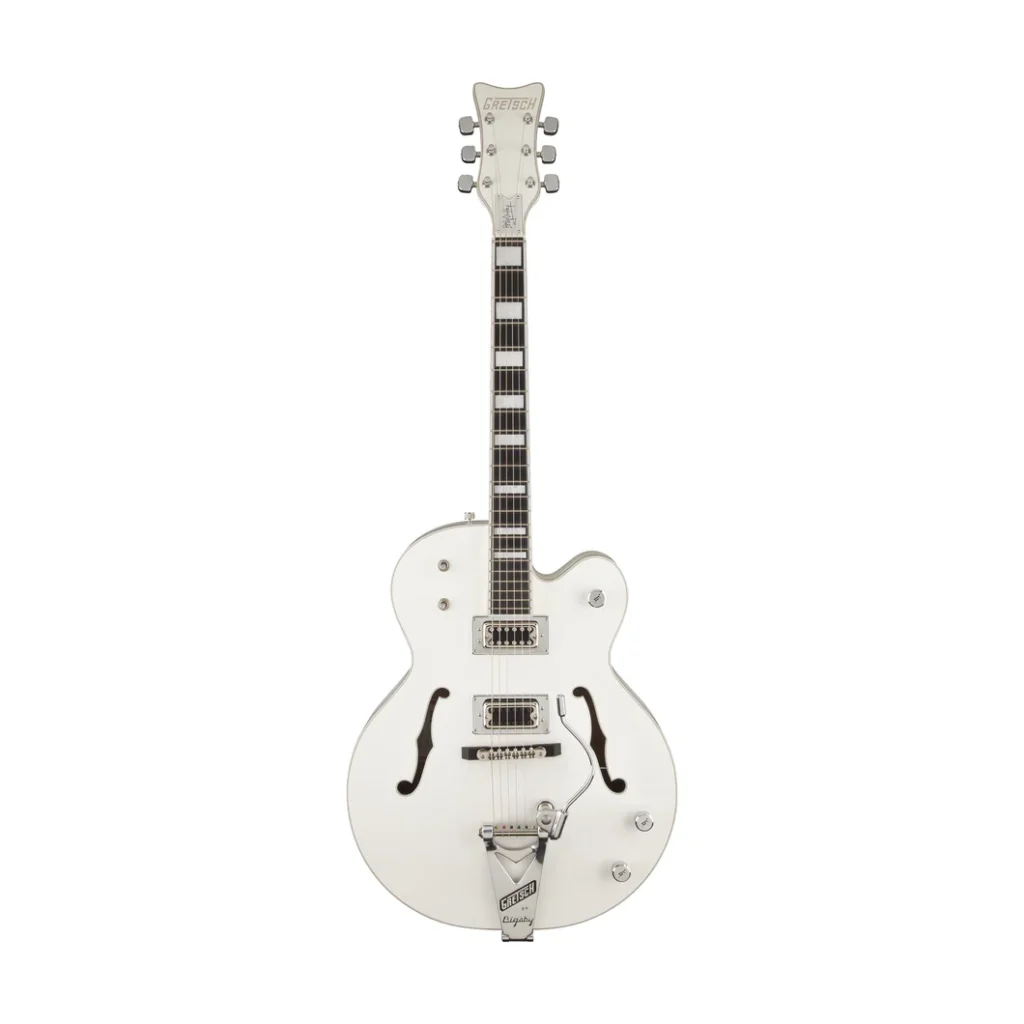
Billy Duffy, lead guitarist for The Cult, is a rock titan whose journey from Manchester, England to global rock stages has been nothing short of inspiring.
His unique style, coupled with an undeniable flair has solidified his status as a true rock legend. Duffy’s playing style is both aggressive and melodic, a combination that has made songs like “Fire Woman” and “Love Removal Machine” rock staples.
His collaboration with Gretsch has resulted in a guitar that reflects Duffy’s artistry, spirit, and passion for music.
Table of Contents
Who Is Billy Duffy?
William Henry Duffy was born on May 12, 1961 in Manchester, England. He is of Irish and Jewish descent and ancestry. Manchester in the late 70s and early 80s was a cauldron of musical innovation. Billy began playing guitar at the age of fourteen, becoming influenced by the music of Queen, Thin Lizzy, The Who, Aerosmith, Blue Öyster Cult and Led Zeppelin.
In the late 1970s, while still at school, he became involved in the punk movement. During this period, his influences included the New York Dolls, The Stooges, Buzzcocks and The Sex Pistols, as well as AC/DC. He played lead guitar in several different punk bands, including Studio Sweethearts.
After leaving school, Billy Duffy left Manchester when Studio Sweethearts moved to London, and took a job as a shop assistant at Johnsons on the King’s Road in Chelsea. Studio Sweethearts subsequently disbanded, and Duffy began playing lead guitar in a band called Theatre of Hate.
Soon after, he met Ian Astbury, the frontman/lead vocalist of Southern Death Cult. Astbury was so impressed with Duffy’s playing that he left Southern Death Cult to form a new band with him called Death Cult. After releasing two singles, the band shortened their name to The Cult.
The band’s fusion of hard rock, goth rock, and post-punk elements made them a sensation, and Duffy’s guitar work was central to their distinctive sound.
On The Cult’s debut single, “Spiritwalker,” Billy Duffy created a distinctive flanged sound using a mid-1970s Gretsch White Falcon guitar, which would later become Duffy’s main instrument.
Their debut album, Dreamtime, was released in 1984, followed by their second album, Love (1985), which featured the hit “She Sells Sanctuary.” For The Cult’s third album, 1987’s Electric, Billy Duffy changed their sound to a metal blues sound.
In 1988, Duffy and Astbury moved to Los Angeles, where they turned to stadium rock and recorded Sonic Temple. The Cult reached a wider, mainstream audience, but their next album, Ceremony, was not successful.
After the 1992 “Ceremonial Stomp” tour, Astbury pressured Duffy to return to his previous style. This eventually led to Astbury leaving The Cult in 1995.
During The Cult’s four-year hiatus, Billy Duffy played with Mike Peters of The Alarm in a project called Coloursound. Duffy also played on the title track of Japanese musician J’s 1997 debut album Pyromania.
Duffy and Astbury reformed The Cult in 1999, leading to a new recording contract with Atlantic Records. They then performed at the Music Midtown festival in Atlanta in May 2001. The album Beyond Good and Evil was later released.
Their promotional single “Rise” was pulled from radio play a week after the album’s release. Disappointing sales, reviews, and tour attendance followed. The project was put on hiatus. In 2002, Astbury accepted an offer to become the vocalist for The Doors.
In early 2004, Billy Duffy formed a cover band called Cardboard Vampyres with Alice in Chains guitarist/vocalist Jerry Cantrell. The band played various venues in the United States between 2004 and 2005. They mainly played on the West Coast. However, the band never released an album.
The Cult reunited in early 2006. After playing a few shows in the United States, they went on a European tour.
In early 2006, Billy Duffy recorded the debut album with his new band Circus Diablo. The album was recorded with Duffy playing lead guitar and former The Cult touring bassist Billy Morrison (bass, vocals).
In 2007, Billy Duffy was a judge on Bodog Music’s Battle of the Bands. In October 2012, he performed with Sammy Hagar and Michael Anthony at the Cabo Wabo Cantina for Sammy Hagar’s birthday party in Cabo San Lucas, Mexico.
In October 2007, their 8th studio album, Born Into This, was released. More live shows followed, including several support slots for The Who.
The next few years were spent mostly performing with The Cult. This period included a tour in support of the reissue of their classic 1985 album Love and a sold-out show at London’s Royal Albert Hall where they performed the album in its entirety.
2010 saw more shows in the US, New Zealand, Australia and Japan, as well as the release of The Capsule EPs, produced by Chris Goss, The Cult’s first new songs since 2007.
After this long period of mostly touring, Billy and Ian spent much of 2011 in the studio working on their 9th album, Choice of Weapon. Originally produced by Chris Goss and later completed by Bob Rock (Sonic Temple, The Cult, Beyond Good & Evil), Choice of Weapon was released in May 2012 to widespread critical acclaim from the rock press. A digital release of Weapon of Choice followed in October 2012.
On July 13, The Cult released Electric Peace, a double disc containing both the original Rick Rubin-produced 1989 album Electric and the never-before-released Peace, which featured earlier versions of the songs. This was followed by the Electric 13 tour, which saw The Cult perform the 1987 album in its entirety to sold-out crowds in the US. The Electric 13 tour will head to the UK, Europe and then back to the US and Canada in the fall.
Billy Duffy performed with Kings of Chaos between 2012 and 2016.
On February 5, 2016, The Cult released their new studio album, Hidden City. In support of Hidden City, they opened for Guns N’ Roses on the Not in This Lifetime Tour.
In the summer of 2018, they performed as one of three headliners along with Stone Temple Pilots and Bush on the Revolution 3 Tour in the United States.
On May 2, 2019, The Cult world tour began in Houston, Texas, which ended in 2020. The band celebrated the anniversary of their fourth album, Sonic Temple.
On May 6, 2020, the band announced on their Twitter page that they had signed a deal with Black Hill Records.
On 15 August 2020, Billy Duffy announced that the band were recording their eleventh studio album with producer Tom Dalgety at Rockfield Studios, where The Cult recorded their debut studio album Dreamtime 36 years earlier. The album was recorded over the course of two years. Due to the COVID-19, the album was recorded remotely, with half the band recording at Rockfield and Astbury Studios in the United States. The album, titled Under the Midnight Sun, was released on 7 October.
Ahead of the release, The Cult will embark on a co-headlining six-date UK tour with Alice Cooper and Creeper in May and June 2022, and will tour North America the following month with Black Rebel Motorcycle Club and Zola Jesus.
On 14 August 2023, Astbury and Duffy announced a 12-date UK tour, as well as one US show in Los Angeles, billed as “Death Cult 8323.”
Billy Duffy is known for playing Gretsch White Falcon and Gibson Les Paul Custom guitars throughout his career. In January 2013, Gretsch introduced the Billy Duffy White Falcon Guitar G7593T.
Gretsch G7593T Billy Duffy Signature Falcon

Billy Duffy’s love affair with the Gretsch White Falcon began in the early days of his career. The visual appeal of the instrument, combined with its unique tonal properties, made it a favorite for Duffy.
Recognizing the special relationship between the artist and the instrument, Gretsch sought to immortalize it with the G7593T Billy Duffy Signature Falcon.
Design
The G7593T is a thing of beauty. Its single-cutaway hollow body, finished in a gleaming white gloss, immediately grabs attention. The silver sparkle binding, combined with the engraved gold pickguard showcasing Billy Duffy’s signature, adds a touch of class to the already elegant design. And let’s not forget the oversized F-holes and the striking ebony fretboard with pearloid Neo-Classic thumbnail inlays.
Sound and Hardware
The guitar comes equipped with a TV Jones Power’Tron (bridge) and a custom-wound DynaSonic (neck) pickup. These pickups, chosen by Billy Duffy himself, ensure that the guitar doesn’t just look good but sounds phenomenal too.
The Bigsby B6CW vibrato tailpiece allows for those smooth, wavy sound manipulations that Duffy is known for, and the pinned rocking bar bridge ensures stable tuning and enhanced sustain.
Playability
The G7593T isn’t just designed for show. Its standard “U”-shaped maple neck ensures comfortable playability, whether you’re chugging out power chords or exploring the higher frets for solos. The medium-jumbo frets, combined with the 12” radius of the fretboard, ensure that your fingers can dance across the strings with ease.
Specification Table
| Category | Specification |
|---|---|
| General | |
| Brand: | Gretsch |
| Year: | 2015 |
| Configuration: | HH |
| Strings: | 6 |
| Made in: | Japan |
| Series: | Professional Collection |
| Colors: | White |
| Left-Handed Version: | No |
| Body | |
| Top: | Arched Laminated Maple |
| Type: | Hollowbody |
| Body Material: | Laminated Maple |
| Bridge: | Bigsby B6CW with Wire Handle |
| Neck | |
| Neck Joint: | Set |
| Tuners: | Grover Imperial with Butter-Bean Buttons |
| Fretboard: | Ebony |
| Neck Material: | 3-Piece Maple/Walnut/Maple |
| Decoration: | Pearloid Big Block |
| Scale Size: | 25.5″ |
| Shape: | Standard U |
| Thickness: | 1st Fret: 0.83” (21.1mm) – 12th Fret: 0.97” (24.6mm) |
| Frets: | 22 Medium Jumbo |
| Fretboard Radius: | 12″ |
| Nut: | Bone |
| Nut Width: | 43.4mm (1.71”) |
| Electronics | |
| Switch: | 3 Way |
| Knobs: | Speed |
| Pickup Mods: | Multi-Voicing |
| Volume Controls: | 3 |
| Tone Controls: | 0 |
| Bridge Pickup: | Gretsch Custom Wound Black Top Filter’Tron (Humbucker / Passive) |
| Neck Pickup: | Gretsch Custom Wound Black Top Filter’Tron (Humbucker / Passive) |